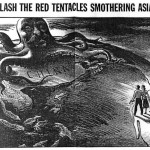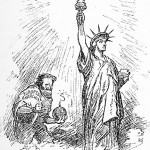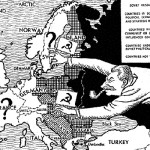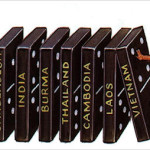
The Vietnam War unfolded amidst the Cold War, a long period of international rivalry and confrontation. Between 1946 to the early 1990s the world was strongly divided between two competing power blocs: capitalist democracies led by the United States and western Europe, and communist states led by the Soviet Union and Maoist China. The Cold War created an atmosphere of tension, suspicion and paranoia. In the West, people were conditioned to think of communism as an evil menace, bent on taking over the world and imposing totalitarian rule. Citizens in communist states were taught that Western nations were governed by greedy imperialists who exploited workers. The Cold War was not just about different ideas and values: it had real and dangerous political and military implications. There was always the risk of conflict and – worst of all – of nuclear war.
The origins of the Cold War date back to 1917 when communist revolutionaries called the Bolsheviks seized power in Russia. The Bolsheviks were led by Vladimir Ulyanov, better known as Lenin, and their movement was based largely on the writings of Lenin and Karl Marx. A 19th-century political philosopher, Marx predicted the eventual fall of capitalism and the rise of socialism, or the ‘dictatorship of the working-classes’. The Russian revolutionaries sought to destroy elements of the old order in their country: monarchy, aristocracy, privilege, religion and exploitation of peasants and workers. They pledged to build a new society where the common people controlled their own destiny. As they rebuilt their new country, now called the Soviet Union, they also hoped to export communist ideology to other parts of the world, to stimulate an ‘international revolution’.

American capitalists were stricken with fear at the prospect of communism spreading and taking root in countries like the United States. Politicians and capitalists were already working to suppress worker discontent and unionism in the US. If America was infiltrated by communist agents and agitators, it would at the very least increase militant unionism. Unrest would lead to strikes, which would breed public disorder and possibly political violence, such as riots and assassinations. By 1919 there was already some evidence of this militancy, with an outbreak of strikes by coal miners, steelworkers and police in Boston. Between April and June, letter bombs were delivered to prominent political figures. The US was soon gripped by a ‘Red Scare’, as conservatives and the alarmist media claimed the nation was under attack from communist infiltrators.
This Red Scare died down by late 1920 but anti-communist paranoia continued to simmer in American politics and society. Suspicions about the Soviet Union and its leaders were temporarily set aside during World War II when the two nations united to defeat Nazi Germany and Imperial Japan. Vietnamese nationalists led by Ho Chi Minh played a small part in this struggle, assisting with the escape and repatriation of American pilots downed in Indochina. The end of World War II produced some hope of a new peace. At three high-level conferences in 1945, Soviet dictator Joseph Stalin met with American and British leaders to thrash out agreements about the post-war world. Some optimists hoped the United States and the Soviet Union might set aside their political differences, to seek better relations and a peaceful coexistence. It was a forlorn hope, however, made impossible by too much mistrust and suspicion on both sides.

Post-war American leaders were concerned about Soviet imperialism and with some reason. The Soviet Red Army invaded eastern Europe in 1944-45 to drive out the Nazis – but after the Allied victory in May 1945 Soviet forces were slow to withdraw from occupied countries. Instead, Soviet agents worked behind the scenes in these regions, engineering puppet regimes and pro-Moscow governments. By the end of the 1940s, Eastern Europe was a jigsaw of Soviet satellite states. They were nominally independent but remained loyal to Moscow. This communist bloc included nations like East Germany, Poland, Hungary, Czechoslovakia and Romania. Their borders of Soviet bloc nations were tightly controlled, behind what Winston Churchill called the Iron Curtain. Post-war Germany became something of a model for the divided Europe. By 1949 it was split into two separate nations: democratic West Germany and communist East Germany. The city of Berlin, located deep in East German territory, was itself divided into Western and Soviet zones.
The United States issued two decisive responses to Soviet expansion. The first was a policy position called the Truman Doctrine, outlined in a 1947 speech by President Harry S. Truman. The United States, Truman said, would take measures to “support free people who are resisting attempted subjugation by armed minorities or by outside pressures” from “totalitarian regimes”. The Truman Doctrine was both a sharp criticism of the Soviet Union and a roadmap for American foreign policy. “The seeds of totalitarian regimes are nurtured by misery and want,” Truman explained. “They reach their full growth when the hope of a people for a better life has died. We must keep that hope alive.” Later that year Truman’s administration also unveiled the European Recovery Program, or Marshall Plan, a plan for foreign loans to war-ravaged nations. The Marshall Plan would eventually provide more than $US13 billion for European reconstruction. The Marshall Plan was not just an act of American generosity: it had quite clear political motives. American aid money came with conditions for nations who sought it: reject communism, embrace democracy, rebuild economies on capitalist lines and be prepared to trade freely in the global economy.

As well as encouraging democracy and capitalism in post-war Europe, America also developed its own military strategy for resisting communist expansion. This revolved around two strategies: containment and the Domino Theory. The idea of containment was first expressed by the American diplomat George Kennan in July 1947. Kennan’s advice to President Truman was that America must contain the spread of communism by using alliance networks, financial aid and, if necessary, military force. If communist regimes and movements were not contained, vulnerable nations would “fall like dominos”. Communism and its agents were subversives who worked behind the scenes in fragile governments and societies. They did not respect borders and were not restricted by them. According to the Domino Theory, if one nation fell under the grip of communism then its neighbours too would eventually succumb.
“Vietnam presents the student of the Cold War with a great paradox. On the one hand, the United States and the Soviet Union seemed to be moving towards a more stable and much safer relationship in the aftermath of the Cuban missile crisis. The Cold War glacier truly seemed to be melting. Yet at the same time, the US was inching closer to war on the distant south-east Asian periphery – for self-professed Cold War reasons.”
Robert J. McMahon, historian
The Domino Theory became increasingly relevant to Asia after the rise of communist China. In 1949 Chiang Kai Shek’s US-backed nationalist government was driven out of China by communist revolutionaries, led by Mao Zedong. On October 1st 1949, Mao stood in Beijing’s Tiananmen Square and proclaimed the People’s Republic of China, the world’s newest communist state. The communist revolution in China transformed the balance of power in Asia. It also shifted Cold War attentions to the eastern hemisphere. The prevailing view in the West was that Chinese communism would not remain within its own borders. China and the Soviet Union had already installed a communist dictator, Kim Il Sung, in neighbouring North Korea. Vietnam was another obvious target. If communism took root there then it might spread to Laos, Cambodia, Thailand, Malaya and Indonesia. Vietnam was, according to John F. Kennedy, “the cornerstone of the free world, the keystone to the arch, the finger in the dyke… and the proving ground for democracy in Asia”.

1. The Cold War was a long period of tension, suspicion and paranoia that began after the conclusion of World War II and lasted until the 1990s.
2. The Cold War was a political, ideological and cultural struggle between the democratic capitalist West and communist nations in eastern Europe and Asia.
3. By 1950 Europe’s capitalist and communist nations were divided by an ‘Iron Curtain’, while the Asian hemisphere was transformed by a communist victory in China.
4. US foreign policy was based on the containment of communist and the Truman Doctrine, which promise to support nations at risk from communism.
5. American interest soon turned to Vietnam, where nationalism, the Viet Minh and its proximity to China meant it was in danger of succumbing to communist control.
© Alpha History 2018. Content on this page may not be republished or distributed without permission. For more information please refer to our Terms of Use.
This page was written by Jennifer Llewellyn, Jim Southey and Steve Thompson. To reference this page, use the following citation:
J. Llewellyn et al, “Cold War conflict”, Alpha History, accessed [today’s date], https://alphahistory.com/vietnamwar/cold-war-conflict/.
